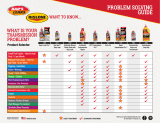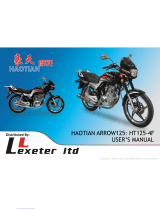ENGLISH
12
DRIVING INSTRUCTIONS »
Shifting/Riding
You are now in first gear, referred to as the drive or uphill gear.
Depending on the conditions (hill size, etc.), you can shift to a higher
gear. Turn down the throttle, at the same time pull the clutch lever
in and shift to the next higher gear. Let the clutch lever go again
and open the throttle. If you turned on the choke, make sure you
turn it off again as soon as engine is warm.
When you reach full speed through opening the throttle all the way,
turn throttle back to 3/4; the speed hardly decreases although the
engine will use less gas. Only give as much gas as the engine can
handle. Through quick and high revving of throttle, the gas con-
sumption will increase. When shifting down, use the brakes if nec-
essary and turn down at the same time. Pull the clutch lever and
shift down to the next lower gear. Let the clutch lever go slowly
and open the throttle or shift down again.
– After falling with the motorcycle, check all its functions thor-
oughly before using it again.
– A twisted handlebar must always be replaced. Do not adjust
the handlebar, it will lose stability.
– High rpm rates when the engine is cold have an adverse effect
on the life of your engine. We recommend you run the engine
in a moderate rpm range for a few miles giving it a chance to
warm up. After that no further precautions in this respect need
to be taken.
– Never have the throttle wide open when changing down to a
lower gear. The engine will overrev, damaging the valves. In addi-
tion, the rear wheel will block so that the motorcycle can eas-
ily get out of control.
– If the engine runs without throttle during longer downhill travel,
the engine should be accelerated occasionally to ensure that
it is supplied with sufficient lubricant which is mixed in the
fuel.
– In the event that, while riding on your motorcycle, you notice
any unusual operation-related noise, stop immediately, turn the
engine off, and contact an authorized KTM dealer.
Braking
Turn off the gas and apply the hand and foot brakes at the same
time. When driving on sandy, wet or slippery ground, use mainly
the rear wheel brake. Always brake with feeling, blocking wheels
can cause you to skid or fall. Also change down to lower gears depend-
ing on your speed.
– In case of rain, after washing the motorcycle, after rides through
water and in case of rides on wet off-road tracks, humid or dirty
brake discs can delay the braking effect. The brakes must be
pulled until they are dry or clean.
– Rides on salt-strewed or dirty roads can also delay the
braking effect. The brakes must be pulled until they are clean.
– Dirty brake discs cause increased tear of brake pads and brake
discs.
– When you brake, the brake discs, brake pads, brake caliper and
brake fluid heat up. The hotter these parts get, the weaker the
breaking effect. In extreme cases, the entire braking system
can fail.
– If the resistance in the hand brake lever or foot brake pedal
feels “spongy” (too much give), this is an indication that some-
thing is wrong with the brake system. Don’t ride your motorcy-
cle anymore without first having the brake system looked over
by a KTM dealer.
Stopping and parking
Close the throttle and apply the hand and foot brake simultane-
ously. Be especially careful when you apply the brakes on sandy,
wet or slick surfaces. Always apply the brakes intuitively, locked
wheels can cause the bike to skid or crash. Shift down to a lower
gear to match your speed. Always apply the brakes before you enter
a curve.
Motorcycle engines produce a great amount of heat while running.
The engine, exhaust pipe, muffler, brake rotors, and shock absorbers
can become very hot. Do not touch any of these parts after start-
ing the motorcycle, and take care to park it where pedestrians are
not likely to touch it and get burned.
– Close the fuel tap when leaving your vehicle. Otherwise the car-
buretor may get flooded and fuel will enter the engine.
– Never park your motorcycle in places where there exist fire haz-
ards due to dry grass or other easily flammable materials.
Refueling, fuel
Unleaded premium gasoline RON 95 mixed with high grade two
stroke oil.
Mixture ratio 125/144 SX: 1:40
Mixture ratio 250 SX: 1:60
Fuel and engine oil should only be mixed immediately before use.
KTM recommends Motorex Cross Power 2T.
Gasoline is highly flammable and poisonous. Extreme caution
should be used when handling gasoline. Do not refuel the motor-
cycle near open flames or burning cigarettes. Always switch off the
engine before refueling. Be careful not to spill gasoline on the engine
or exhaust pipe while the engine is hot. Wipe up spills promptly.
If gasoline is swallowed or splashed in the eyes, seek a doctor’s
advice immediately.
– Only use premium-grade gasoline ROZ 98 respectively 95
mixed with high-grade two-stroke engine oil. Other types of gaso-
line can cause engine failure.
– Do not use premixed two-stroke oils, oils for outboard engines
or normal engine oil to prepare the mixture.
– Do not use gasoline and oil mixtures that are older than one
week. The lubrication properties of some two-stroke oils can
deteriorate very rapidly.
– Only use known brands of high-grade 2-stroke engine oil (i.e.
Motorex Cross Power 2T).
– Never mix synthetic oils and mineral oils.
– Not enough oil or low-grade oil can cause erosion of the pis-
ton. when Using too much oil, the engine may start smoking
and foul the spark plug.
– If your motorcycle is equipped with a catalytic converter, always
keep in mind that leaded fuel will destroy the catalytic converter.
– Fuel expands when its temperature rises. Therefore do not fill
the tank to the top. (see fig.)
– The tank cap's locking mechanism always has to snap into place
when it is mounted.























